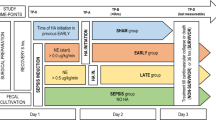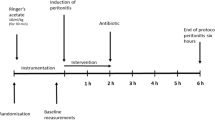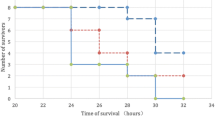Abstract
Objective: to compare diafiltered 6% pentastarch (Pentafraction-PDP, MWn 120000 and MWw 280000) and native pentastarch (Pentaspan-PSP, MWn 63000 and MWw 264000 dalton) in a porcine model of faecal peritonitis.Design: Randomised prospective study in 12 adolescent pigs.Interventions: Prior to infection the study solution was infused to increase Qt by 25%. Thereafter adjustments in infusion rate were made (up to 1 l/h) in an attempt to maintain Qt at 25% above baseline values.Measurements and results: Animals were sacrificed at 8h. Tissue was excised from the right lobe of liver and from the right lung and fixed for later electron microscopy and digital morphometric analysis. Patent sinusoidal lumen was significantly greater in group PDP compared to PSP (11.3%±2.3% of liver tissue versus 4.8%±1.1%,p<0.05) and this was accounted for by a significantly lower proportion of sinusoidal lumen occluded with white cells (2.1%±0.6% versus 6.6%±1.9%,p<0.05). Similarly, patent capillary represented a significantly higher proportion of lung tissue for group PDP versus PSP (26.2%±1.9% versus 18.5%±2.7%,p<0.05). The arithmetic mean alveolar capillary barrier thickness was significantly greater in group PSP than in group PDP (4.3±03 μm versus 2.5±03 μm,p<0.01).Conclusions: The molecular weight profile of Pentafraction was associated with less structural organ damage including less tissue oedema and less white cell occlusion.
Similar content being viewed by others
References
Knaus WA, Draper EA, Wagner DP, Zimmerman JE (1985) Prognosis in acute organ-system failure. Ann Surg 202:685–693
Cavanagh D, Rao PS, Sutton MC, Bhagat BD, Bachmann F (1970) Pathophysiology of endotoxic shock in the primate. Am J Obstet Gynecol 108:705–722
Coalson JJ, Hinshaw LB, Guenter CA, Berrell EL, Greenfield LJ (1975) Pathophysiologic responses of the subhuman primate in experimental septic shock. Lab Invest 32:561–569
Danek SJ, Lynch JP, Weg JG, Dantzker DR (1980) The dependence of oxygen uptake on oxygen delivery in the adult respiratory distress syndrome. Am Rev Respir Dis 122:387–395
Jacob HS, Craddock PR, Hammerschmidt DE, Moldow CF (1980) Complement induced granulocyte aggregation. An unsuspected mechanism of disease. N Engl J Med 302:789–794
Tighe D, Moss RF, Boghossian S, Heath MF, Chessum B, Bennett ED (1989) Multi-organ damage resulting from experimental faecal peritonitis. Clin Sci 76:269–276
Shoemaker WC, Appel PL, Kram HB, Waxman K, Lee TS (1988) Prospective trial of supranormal values of survivors as therapeutic goals in high-risk surgical patients. Chest 94:1176–1186
Edwards JD, Brown CS, Nightingale P, Slater R, Farragher EB (1989) Use of survivors' cardio-respiratory values as therapeutic goals in septic shock. Crit Care Med 17:1098–1103
Ellman H (1984) Capillary permeability in septic patients. Crit Care Med 12:629–633
Sugarman HJ, Tatum JL, Burke TS, Strash AM, Glauser FL (1984) Gamma scintigraphic analysis of albumin flux in patients with acute respiratory distress syndrome. Surgery 95:674–681
Fleck A, Raines G, Hawker F, Trotter J, Wallace PI, Ledingham IMcA, Colman KC (1985) Increased vascular permeability: a major cause of hypoalbuminaemia in disease and injury. Lancet I:781–783
Groeneveld ABJ, Teule GJJ, Bronsveld W, van den Bos GC, Thijs LG (1987) Increased systemic microvascular albumin flux in septic shock. Intensive Care Med 13:140–142
Parker MM, Shelhamer JH, Bacharach SL, Green MV, Natanson C, Frederick TM, Damske BA, Parillo JE (1984) Profound but reversible myocardial depression in patients with septic shock. Ann Intern Med 100:483–490
Parker MM, McCarthy KE, Ognibene FP, Parillo JE (1988) Septic shock in humans produces similar patterns of left and right ventricular dysfunction and dilatation. Clin Res 36:373A
Ognibene FP, Parker MM, Natanson C, Shelhamer JH, Parillo JE (1988) Depressed left ventricular performance in response to volume infusion in patients with sepsis and septic shock. Chest 93:903–910
Haupt MT, Rackow EC (1982) Colloid osmotic pressure and fluid resuscitation with hetastarch, albumin, and saline solutions. Crit Care Med 10:159–162
Demling RH, Manohar M, Will JA (1980) Response of the pulmonary microcirculation to fluid loading after haemorrhagic shock and resuscitation. Surgery 87:552–559
Shoemaker WC, Schluchter M, Hopkins JA, Appel PL, Schwartz S, Chang P (1981) Fluid therapy in emergency resuscitation: clinical evaluation of colloid and crystalloid regimens. Crit Care Med 9:367–368
Grotte G (1956) Passage of dextran molecules across the blood lymph barrier. Acta Chir Scand 211:1–84
Zikria BA, King TC, Stanford J, Freeman HP (1989) A biophysical approach to capillary permeability. Surgery 105:625–631
Tighe D, Moss R, Hynd J, Boghossian S, Al-Saady N, Heath MF, Bennett ED (1990) Pretreatment with pentoxyfilline improves the hemodynamic and histologic changes and decreases neutrophil adhesiveness in a pig fecal peritonitis model. Crit Care Med 18:184–189
Webb AR, Tighe D, Moss RF, Al-Saady N, Hynd JW, Bennett ED (1991) Advantages of narrow-range, medium molecular weight hydroxyethyl starch for volume maintenance in a porcine model of fecal peritonitis. Crit Care Med 19:409–416
Delesse MA (1847) Procédé mécanique pour déterminer la composition des roches. Comp Rend Acad Sci 25:544
Weibel ER, Kistler GS, Scherle WF (1966) Practical sterological methods for morphometric cytology. J Cell Biol 30:23–38
Webb AR, Barclay SA, Bennett ED (1989) In vitro colloid osmotic pressure of commonly used plasma substitutes: a study of the diffusibility of colloid molecules. Intensive Care Med 15:116–120
Webb AR (1990) The physical properties of plasma substitutes. Clin Intensive Care 1:58–61
Evans SF, Hinds CJ, Varley JG (1984) A new canine model of endotoxin shock. Br J Pharmacol 83:433–442
Hinshaw LB, Beller BK, Archer LT, Flournoy DJ, White GL, Phillips RW (1979) Recovery from lethalEscherichia coli shock in dogs. Surg Gynecol Obstet 149:335–340
Perbellini A, Shatney CH, MacCarter DI, Lillehei RCA (1978) A new model for the study of septic shock. Surg Gynecol Obstet 147:68–74
Mohsenifar Z, Goldbach P, Tashkin DP (1983) Relationship between oxygen delivery and oxygen consumption in the adult respiratory distress syndrome. Chest 84:267–271
Sato T, Tanaka J, Kono Y, Jones RT, Cowley RA, Trump BF (1982) Hepatic cellular injury following lethalEscherichia coli bacteremia in rats. Lab Invest 47:304–310
Luckett PM, Silverstein SC, Zikria BA (1989) Hydroxyethyl starch (HES) decreases hydraulic conductivity (LP) of cultured endothelial monolayers. FASEBJ 3:A1309
Author information
Authors and Affiliations
Rights and permissions
About this article
Cite this article
Webb, A.R., Moss, R.F., Tighe, D. et al. A narrow range, medium molecular weight pentastarch reduces structural organ damage in a hyperdynamic porcine model of sepsis. Intensive Care Med 18, 348–355 (1992). https://doi.org/10.1007/BF01694363
Received:
Accepted:
Issue Date:
DOI: https://doi.org/10.1007/BF01694363




